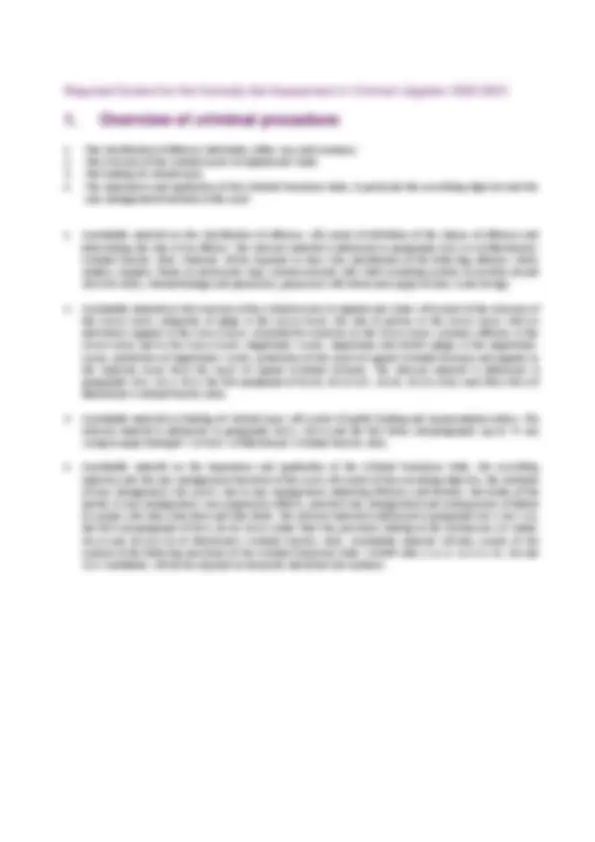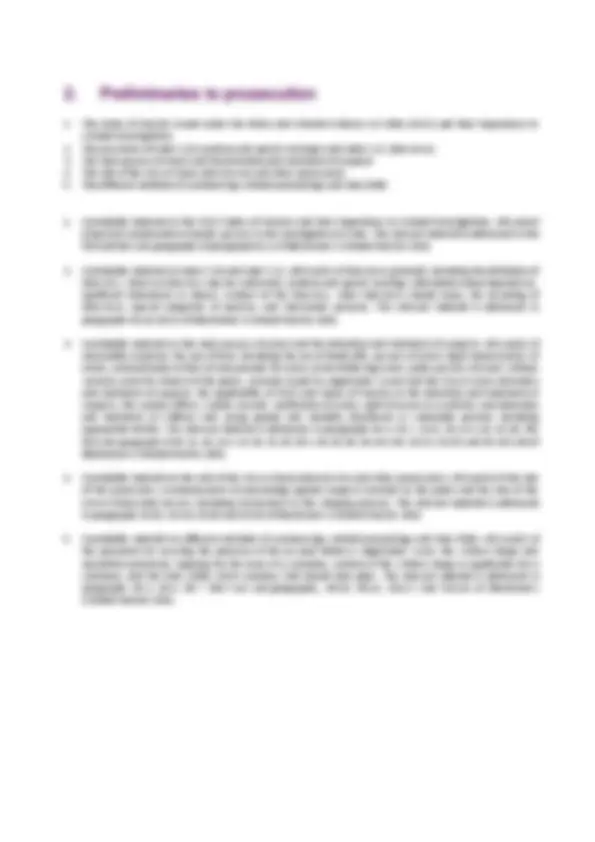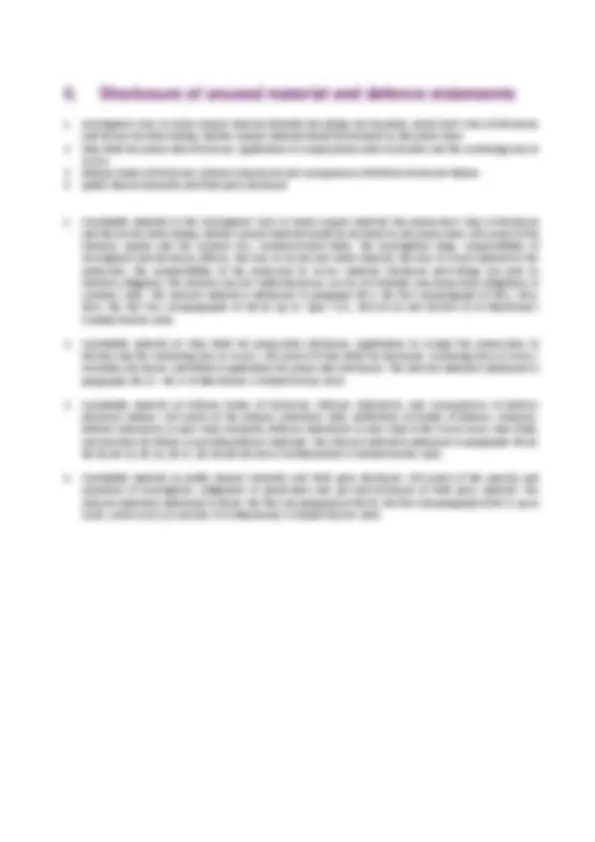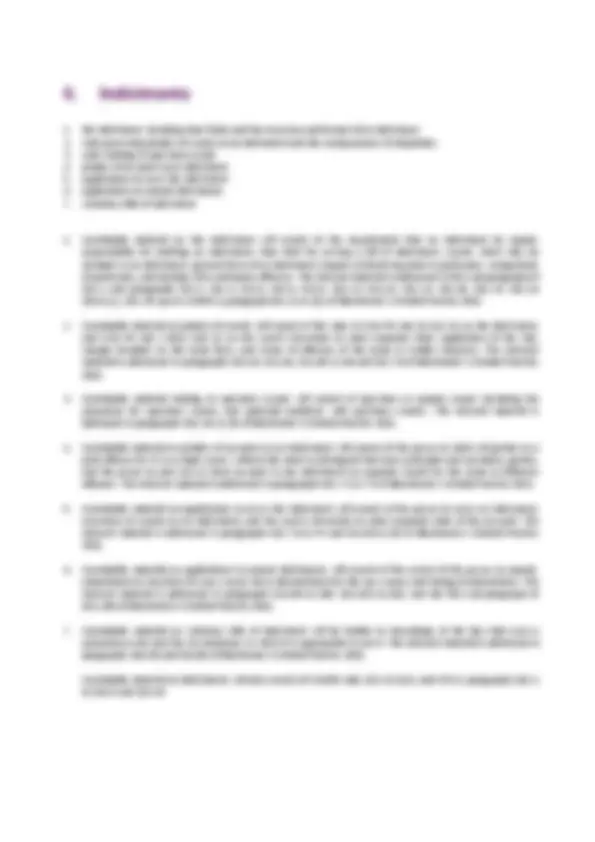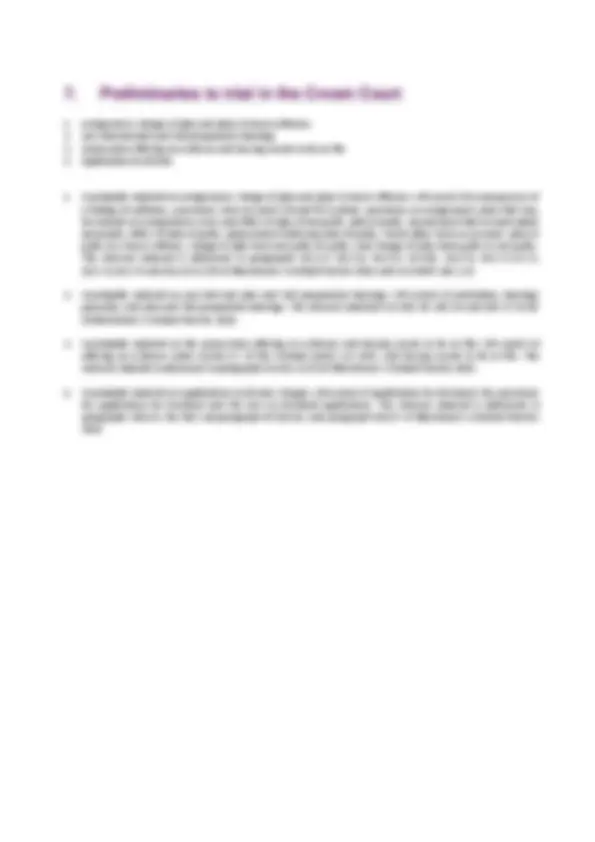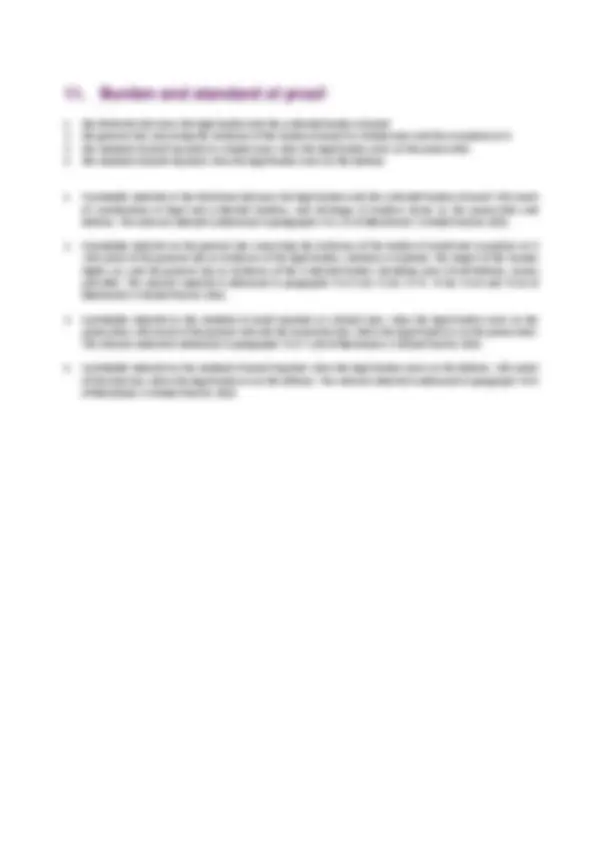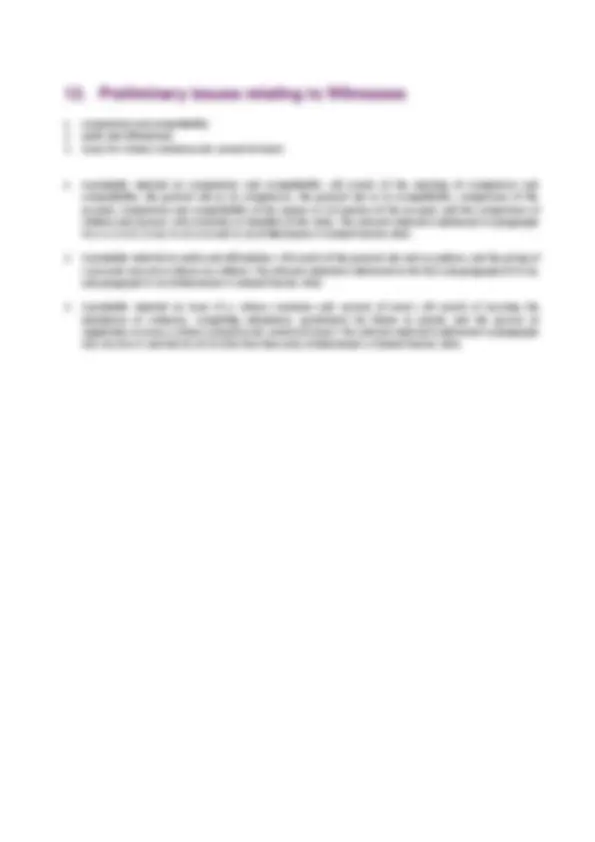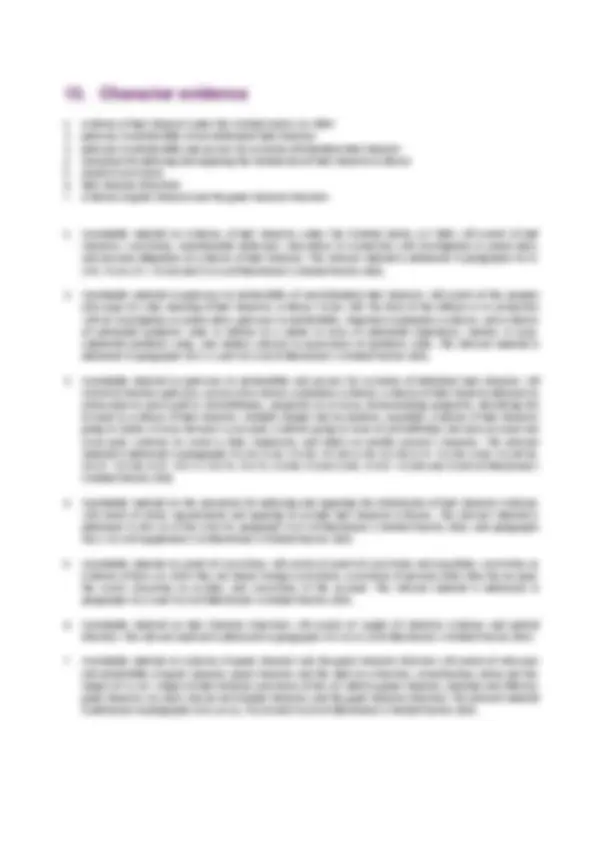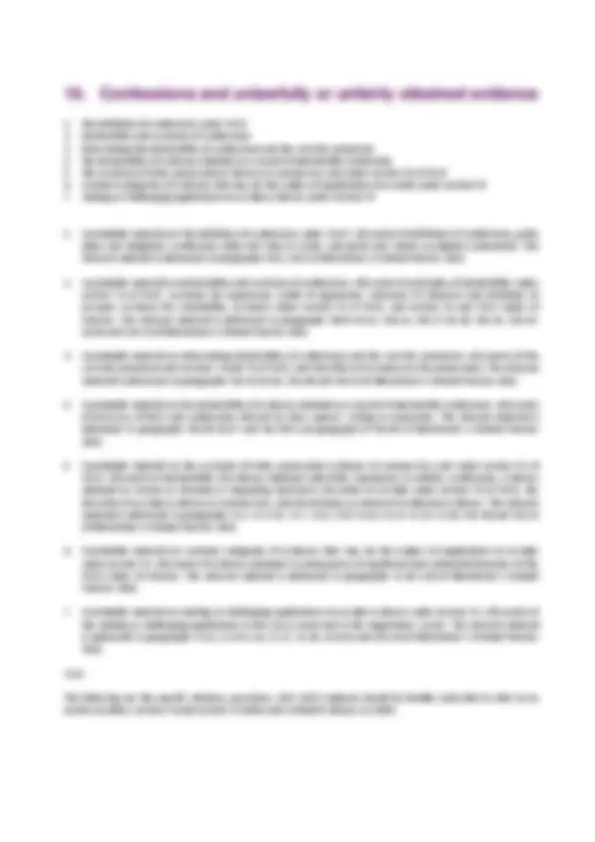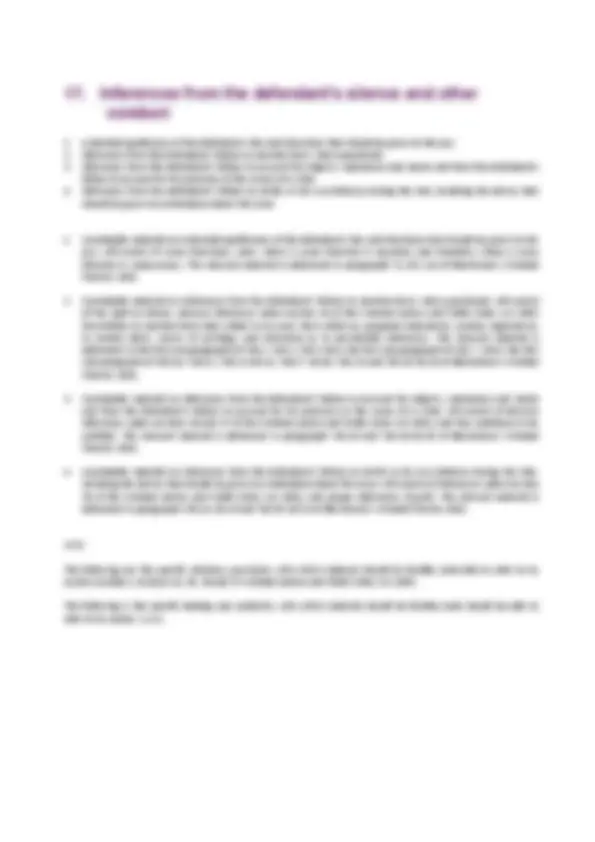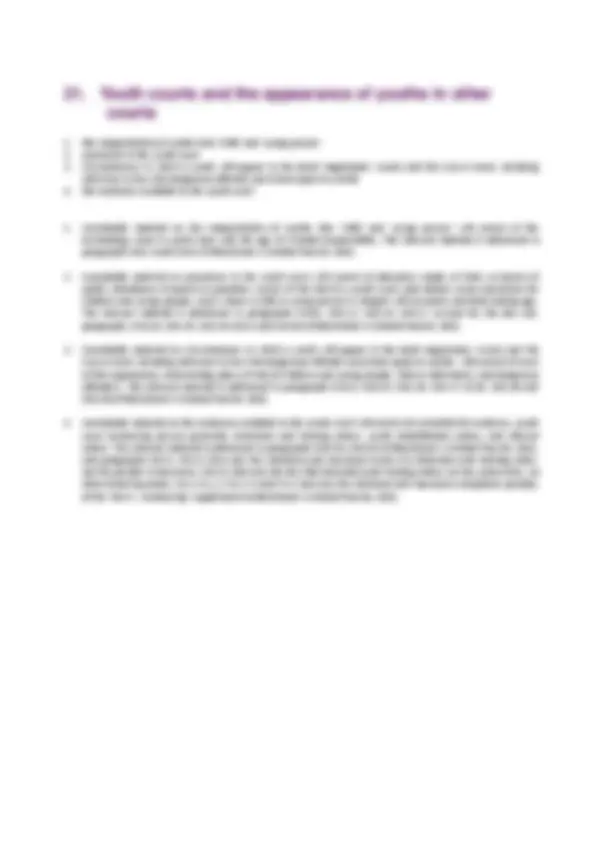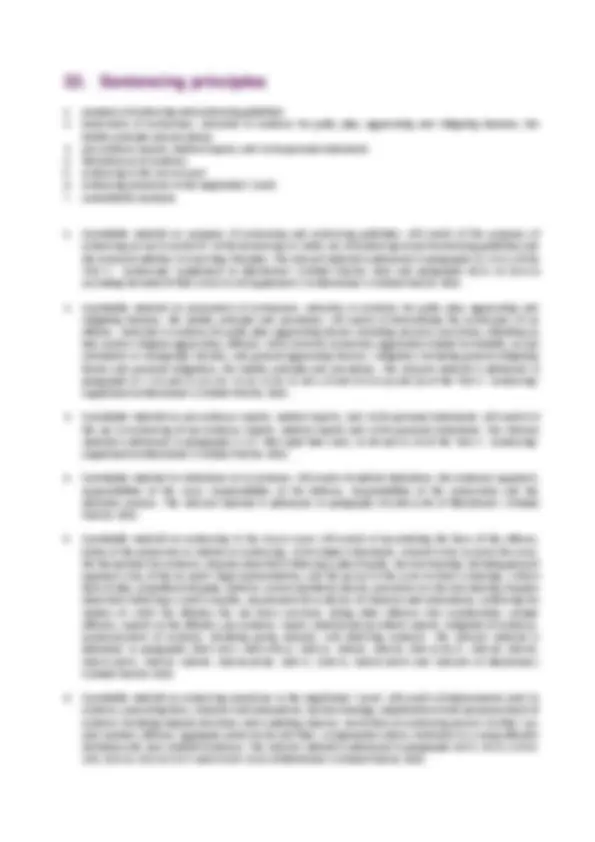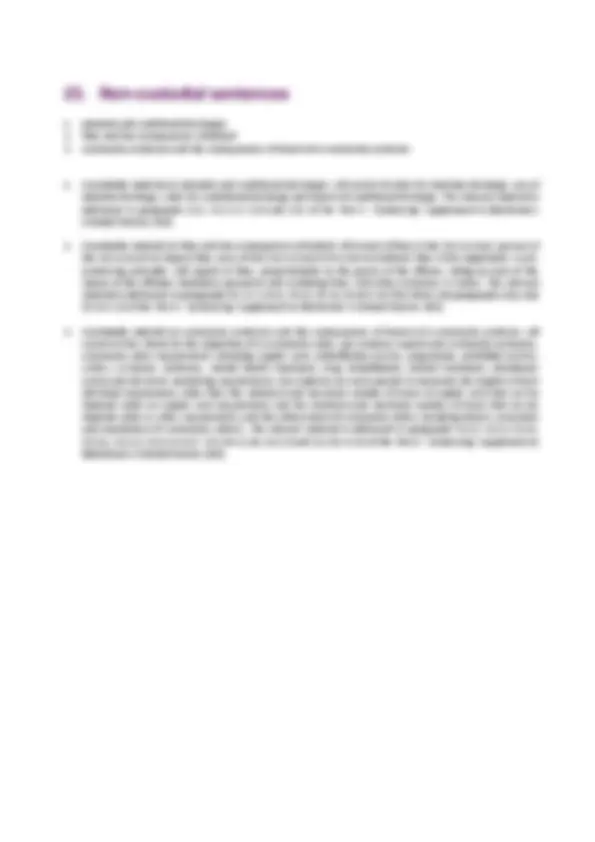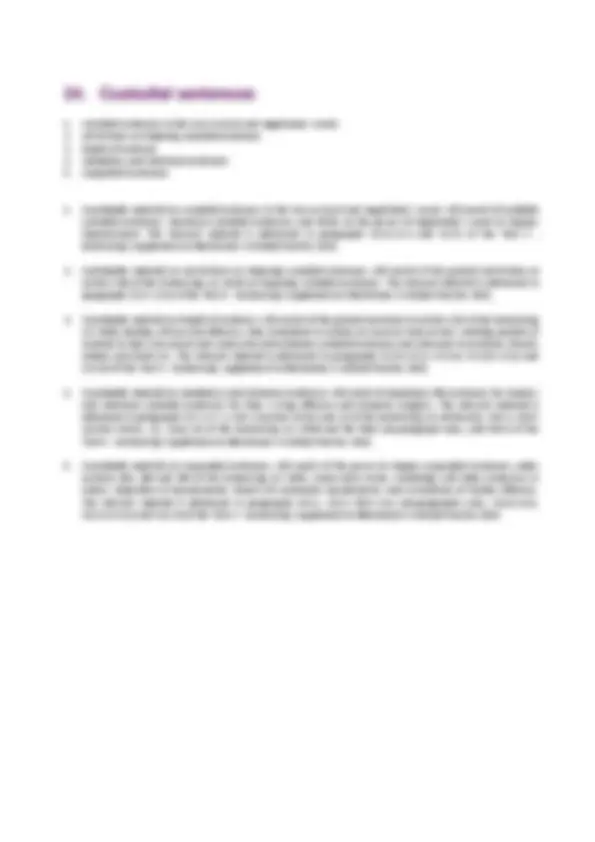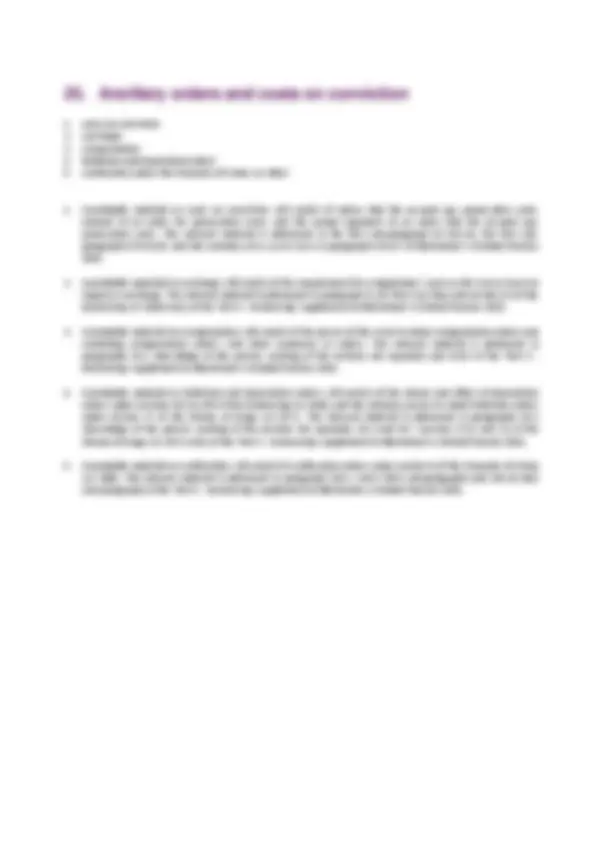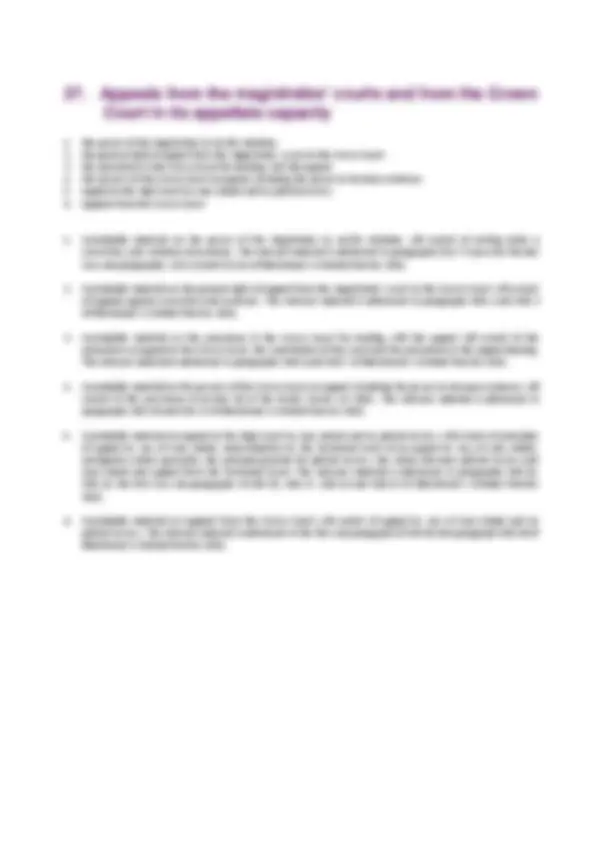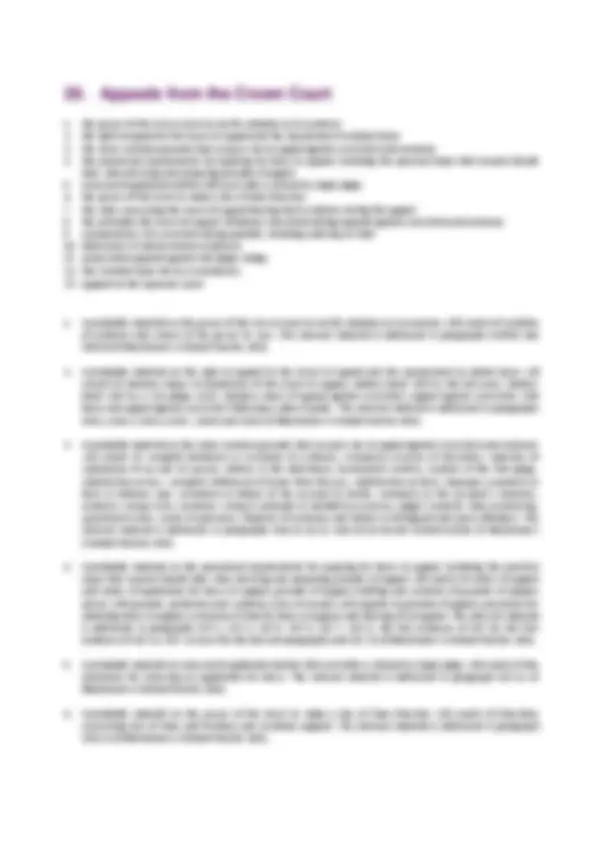Download English Criminal Courts & Evidence: Examinable Material for Litigation and more Summaries Criminal Justice in PDF only on Docsity!
Criminal litigation, evidence and sentencing:
Bar Training syllabus and curriculum 2021
Syllabus Text
Blackstone’s Criminal Practice 2021
Blackstone’s Criminal Practice 2021 (Part E - Sentencing) Supplement
NB Click on the section title in the contents below to be taken to that section.
- Introduction Contents Page
- Required Content for the Centrally Set Assessments in Criminal Litigation
- Overview of criminal procedure
- Preliminaries to prosecution
- Bail and remands
- trial or sentence 4. Procedure in the magistrates’ courts, allocation for trial, and sending to the Crown Court for
- Disclosure of unused material and defence statements
- Indictments
- Preliminaries to trial in the Crown Court
- Summary trial procedure
- Jury trial procedure
- Preliminary evidential matters
- Burden and standard of proof...................................................................................................
- Preliminary issues relating to Witnesses
- The rules relating to the examination of Witnesses
- Hearsay Evidence
- Character evidence
- Confessions and unlawfully obtained evidence
- Inferences from the defendant’s silence and other conduct
- Visual identification evidence
- Opinion evidence and experts
- Privilege
- Youth courts and the appearance of youths in other courts
- Sentencing principles
- 23 Non-custodial sentences
- 24 Custodial sentences
- 25 Ancillary orders and costs on conviction
- 26 The dangerous offender provisions..........................................................................................
- 27 Appeals from the magistrates’ courts and from the Crown Court in its appellate capacity.....
- 28 Appeals from the Crown Court
Required Content for the Centrally Set Assessment in Criminal Litigation 2020 - 2021
1. Overview of criminal procedure
- The classification of offences (indictable, either-way and summary)
- The structure of the criminal courts in England and Wales
- The funding of criminal cases
- The importance and application of the Criminal Procedure Rules, in particular the overriding objective and the case management functions of the court
- Examinable material on the classification of offences will consist of definition of the classes of offences and determining the class of an offence. The relevant material is addressed in paragraphs D6.1-6.4 of Blackstone’s Criminal Practice 2021. Students will be required to know the classification of the following offences: theft, robbery, burglary, fraud, sexual assault, rape, common assault, ABH, GBH/wounding contrary to sections 18 and 20 OAPA 1861, criminal damage and possession, possession with intent and supply of Class A and B drugs.
- Examinable material on the structure of the criminal courts in England and Wales will consist of the structure of the Crown Court, categories of judge in the Crown Court, the role of justices in the Crown Court, trial on indictment, appeals to the Crown Court, committal for sentence to the Crown Court, summary offences in the Crown Court, bail in the Crown Court, magistrates’ courts, magistrates and district judges in the magistrates’ courts, jurisdiction of magistrates’ courts, jurisdiction of the Court of Appeal (Criminal Division) and appeals to the Supreme Court from the Court of Appeal (Criminal Division). The relevant material is addressed in paragraphs D3.1, D3.2, D3.4, the first paragraph of D3.10, D3.13-3.17, D3. 19 , D3. 23 , D26.1 and D30.3-30.4 of Blackstone’s Criminal Practice 2021.
- Examinable material on funding of criminal cases will consist of public funding and representation orders. The relevant material is addressed in paragraphs D32.1, D32. 6 and the first three sub-paragraphs (up to “It was wrong to apply hindsight.”) of D32. 7 of Blackstone’s Criminal Practice 2021.
- Examinable material on the importance and application of the Criminal Procedure Rules, the overriding objective and the case management functions of the court will consist of the overriding objective, the rationale of case management, the court’s role in case management, balancing efficiency and fairness, the duties of the parties in case management, case progression officers, practical case management and consequences of failure to comply with rules, directions and time limits. The relevant material is addressed in paragraphs D4. 3 , D4. 7 - 4. 8 , the first sub-paragraph of D4. 9 , D4.10, D4. 11 (other than the provisions relating to the Coronavirus Act 2020), D4. 13 and D4. 14 - 4. 16 of Blackstone’s Criminal Practice 2021. Examinable material will also consist of the content of the following provisions of the Criminal Procedure Rules: CrimPR rules 1.1-1.3, 3.2-3.3, 3.5, 3.8 and 3.13. Candidates will not be required to memorise individual rule numbers.
2. Preliminaries to prosecution
- The Codes of Practice issued under the Police and Criminal Evidence Act 1984 (PACE) and their importance to criminal investigations
- The provisions of Code C.10 (cautions and special warnings) and Code C.11 (interviews)
- The main powers of arrest and the detention and treatment of suspects
- The role of the Crown Prosecution Service and other prosecutors
- The different methods of commencing criminal proceedings and time limits
- Examinable material on the PACE Codes of Practice and their importance to criminal investigations will consist of general consideration of police powers in the investigation of crime. The relevant material is addressed in the first and last sub-paragraphs of paragraph D1.1 of Blackstone’s Criminal Practice 2021.
- Examinable material on Code C.10 and Code C.11 will consist of interviews generally (including the definition of interview, where an interview may be conducted, cautions and special warnings, information about legal advice, significant statements or silence, conduct of the interview, when interviews should cease, the recording of interviews, special categories of persons, and intoxicated persons). The relevant material is addressed in paragraphs D1.81-D1.9 2 of Blackstone’s Criminal Practice 2021.
- Examinable material on the main powers of arrest and the detention and treatment of suspects will consist of reasonable suspicion, the use of force (including the use of handcuffs), powers of arrest, legal characteristics of arrest, communication of fact of and grounds for arrest, action following arrest, police powers of arrest without warrant, arrest for breach of the peace, warrants issued by magistrates’ courts and the Crown Court, detention and treatment of suspects, the applicability of PACE and Codes of Practice to the detention and treatment of suspects, the custody officer, custody records, notification of arrest, right of access to a solicitor, and detention and treatment of children and young people and mentally disordered or vulnerable persons (including appropriate adults). The relevant material is addressed in paragraphs D1.4, D1.7, D1.8, D1.14-1.18, D1.20, the first sub-paragraph of D1.21, D1.22-1.23, D1.33, D1.35-1.36, D1.40, D1. 44 - 1.45, D1.52, D1.55 and D1.63-1.6 8 of Blackstone’s Criminal Practice 2021.
- Examinable material on the role of the Crown Prosecution Service and other prosecutors will consist of the role of the prosecutor, commencement of proceedings against suspects arrested by the police and the role of the Crown Prosecution Service (including involvement in the charging process). The relevant material is addressed in paragraphs D3.44, D3.46, D3.49 and D3.50 of Blackstone’s Criminal Practice 2021.
- Examinable material on different methods of commencing criminal proceedings and time limits will consist of the procedure for securing the presence of the accused before a magistrates’ court, the written charge and requisition procedure, applying for the issue of a summons, content of the written charge or application for a summons, and the time within which summary trial should take place. The relevant material is addressed in paragraphs D5.2, D5.4, D5. 7 (first two sub-paragraphs), D5. 10 , D5. 14 , D21. 17 and D21. 18 of Blackstone’s Criminal Practice 2021.
4. Procedure in the magistrates’ courts, allocation for trial, and sending to the Crown Court for trial or sentence
- the rules relating to the provision of initial details of the prosecution case
- preliminary hearings and entering a plea in the magistrates’ court, including ambiguous pleas
- the factors the defendant should be aware of in deciding whether to elect Crown Court trial
- determining allocation (mode of trial) including the special rules for criminal damage and low value shoplifting cases
- committal for sentence
- sending indictable offences to the Crown Court
- the sending of linked summary only offences and the procedure for dealing with them in the Crown Court
- Examinable material on rules relating to the provision of initial details of the prosecution case will consist of knowledge of CrimPR Part 8 , including the time when initial details of the prosecution case must usually be provided together with the options open to the parties and the court in the event of non-compliance by the prosecution. The relevant material is addressed in paragraph D5. 20 of Blackstone’s Criminal Practice 2021.
- Examinable material on preliminary hearings, entering pleas in the magistrates’ courts and ambiguous pleas will consist of pre-trial hearings by live link, proceeding to sentence, pre-trial hearings, preparation for trial hearings, pre-trial rulings, essential case management: applying the criminal procedure rules, and ambiguous pleas. The relevant material is addressed in paragraphs D5.38 (first paragraph only), D5.41, D21. 33 - 21.3 5 , D21.40 and D12.1 00 (which considers ambiguous pleas on indictment) of Blackstone’s Criminal Practice 2021.
- Examinable material on factors the defendant should be aware of in deciding whether to elect Crown Court trial will consist of the respective sentencing powers of the Crown Court and magistrates’ courts, submissions and rulings on the admissibility of evidence in the Crown Court and magistrates’ courts, disclosure of prosecution witness statements in Crown Court and magistrates’ courts, the differing defence disclosure obligations in the Crown Court and magistrates’ courts, and the fact that reasoned decisions for conviction are required in a summary trial. The relevant material is addressed in paragraphs D6. 18 , D9.29, D9.37 and D22.70 of Blackstone’s Criminal Practice 2021.
- Examinable material on determining allocation (mode of trial) will consist of determination of mode of trial, plea before venue, allocation, rules relating to the presence of the accused, legitimate expectations as to sentence, the binding effect of indication of sentence, the magistrates’ decision whether to accept jurisdiction, the prosecution influence on the decision, the special procedure on criminal damage charges, and the special provision for low value shoplifting. The relevant material is addressed in paragraphs D6.6-6.9, D23.35, D6. 12 -
- 17 , D6. 20 - 6. 25 and D6. 27 of Blackstone’s Criminal Practice 2021.
- Examinable material on committals for sentence will consist of powers to commit for sentence and be limited to the fact that there are different provisions relating to different circumstances. The relevant material is addressed in paragraphs D23. 30 , D23. 42 and the first sub-paragraph of D23. 55 of Blackstone’s Criminal Practice
- Examinable material on sending indictable offences to the Crown Court will consist of court of first appearance, sending cases to the Crown Court under section 51 of the Crime and Disorder Act 1998 (including either way offences, the situation where there are co-accused, subsidiary matters and presence of the accused). The relevant material is addressed in paragraphs D10.1 and D10.4-10. 12 of Blackstone’s Criminal Practice 2021.
- Examinable material on sending linked summary offences and dealing with them in the Crown Court will consist of the relevant statutory provisions. Relevant material is addressed in paragraphs D6. 38 , D11.17 and D11.19 of Blackstone’s Criminal Practice 2021.
5. Disclosure of unused material and defence statements
- investigator’s duty to retain unused material (detailed knowledge not required), prosecutor’s duty of disclosure and the test for determining whether unused material should be disclosed by the prosecution
- time limits for prosecution disclosure, applications to compel prosecution to disclose and the continuing duty to review
- defence duties of disclosure, defence statements and consequences of defence disclosure failures
- public interest immunity and third party disclosure
- Examinable material on the investigators’ duty to retain unused material, the prosecutor’s duty of disclosure and the test for determining whether unused material should be disclosed by the prosecution will consist of the statutory regime and the common law, commencement dates, the investigation stage, responsibilities of investigators and disclosure officers, the duty to record and retain material, the duty to reveal material to the prosecutor, the responsibilities of the prosecutor to review material, disclosure post-charge but prior to statutory obligation, the statutory test for initial disclosure, service of schedules and prosecution obligations in summary trials. The relevant material is addressed in paragraph D9.2, the first sub-paragraph of D9.4, D9.6, D9.8, the first five sub-paragraphs of D9.10 (up to ‘para. 5.6’), D9.12-9.16 and D9.18-9.22 of Blackstone’s Criminal Practice 2021.
- Examinable material on time limits for prosecution disclosure, applications to compel the prosecution to disclose and the continuing duty to review will consist of time limits for disclosure, continuing duty to review: secondary disclosure, and defence applications for prosecution disclosure. The relevant material is addressed in paragraphs D9.23 – D9.27 of Blackstone’s Criminal Practice 2021.
- Examinable material on defence duties of disclosure, defence statements, and consequences of defence disclosure failures will consist of the defence statement, alibi, notification of details of defence witnesses, defence statements in cases tried summarily, defence statements in cases tried in the Crown Court, time limits, and sanctions for failure in providing defence materials. The relevant material is addressed in paragraphs D9.29, D9.30, D9.33, D9.34, D9.37, D9.38 and D9.40-9.43 of Blackstone’s Criminal Practice 2021.
- Examinable material on public interest immunity and third party disclosure will consist of the practice and procedure of investigators, obligations of prosecutors and pre-trial disclosure of third party material. The relevant material is addressed in D9. 49 , the first sub-paragraph of D9. 55 , the first sub-paragraph of D9. 71 up to ECHR, Article 6 (R(AL)) ’ and D15. 79 of Blackstone’s Criminal Practice 2021.
7. Preliminaries to trial in the Crown Court
- arraignment, change of plea and pleas to lesser offences
- pre-trial and plea and trial preparation hearings
- prosecution offering no evidence and leaving counts to lie on file
- applications to dismiss
- Examinable material on arraignment, change of plea and pleas to lesser offences will consist of consequences of a finding of unfitness, procedure when accused is found fit to plead, procedure on arraignment, pleas that may be entered on arraignment, entry and effect of plea of not guilty, plea of guilty, requirement that accused plead personally, effect of plea of guilty, adjournment following plea of guilty, mixed pleas from an accused, plea of guilty to a lesser offence, change of plea from not guilty to guilty, and change of plea from guilty to not guilty. The relevant material is addressed in paragraphs D12.13, D12.16, D12.53, D12.58, D12.70, D12.71-12.74, D12.76, D12.79 and D12.93-12.95 of Blackstone’s Criminal Practice 2021 and in CrimPR rule 3. 32.
- Examinable material on pre-trial and plea and trial preparation hearings will consist of preliminary hearings generally, and plea and trial preparation hearings. The relevant material is at D15.39, D15.44 and D15.47-15. 49 of Blackstone’s Criminal Practice 2021.
- Examinable material on the prosecution offering no evidence and leaving counts to lie on file will consist of offering no evidence under section 17 of the Criminal Justice Act 1967, and leaving counts to lie on file. The relevant material is addressed in paragraphs D12.81-12.83 of Blackstone’s Criminal Practice 2021.
- Examinable material on applications to dismiss charges will consist of applications for dismissal, the procedure for applications for dismissal and the test on dismissal applications. The relevant material is addressed in paragraphs D10.23, the first sub-paragraph of D10.24, and paragraph D10.27 of Blackstone’s Criminal Practice
8. Summary trial procedure
- pre-trial rulings
- proceeding in the absence of the defendant
- abuse of process in the magistrates’ courts
- procedural steps in a summary trial, including role of the authorised court officer, the procedure for raising points of law, and the different ways in which evidence may be presented or proved and speeches
- submission of no case to answer
- verdicts
- Examinable material on pre-trial rulings will consist of pre-trial hearings and pre-trial rulings. The relevant material is addressed in paragraph D21.35 of Blackstone’s Criminal Practice 2021.
- Examinable material on proceeding to trial in the absence of the defendant will consist of power to adjourn, the court’s powers and procedure in cases of trial in the absence of the accused, determining whether to proceed to trial in the accused’s absence and warrant for arrest. The relevant material is addressed in CrimPR rule 24. and in paragraphs D5.43, D22.12, D22. 14 , D22. 17 and D22.19 of Blackstone’s Criminal Practice 2021.
- Examinable material on abuse of process in the magistrates’ courts will consist of the effect of delay and the court’s discretion not to proceed on account of delay. The relevant material is addressed in paragraph D21. 21 of Blackstone’s Criminal Practice 2021.
- Examinable material on the procedural steps in a summary trial will consist of the start of the trial, the prosecution opening speech, prosecution witnesses, written evidence at summary trial, formal admissions, objections to prosecution evidence (including objections to admissibility under section 78 and section 76 of PACE), closing speeches, the role of authorised court officers, and the content of CrimPR rule 24 .3. The relevant material is addressed in the first sub-paragraph of D22.36, D22. 37 , D22.38, D22.39, D22. 40 , the first sub- paragraph of D22. 41 , D22. 43 - 22. 44 , D22. 46 , the first sub-paragraph of D22. 47 up to “…obtaining of the confession”; D22. 63 , D22. 80 - 81 of Blackstone’s Criminal Practice 2021.
- Examinable material on making a submission of no case to answer will consist of submissions of no case to answer, the extent to which the court may have regard to the credibility of prosecution witnesses, and the prosecution right of reply. The relevant material is addressed in paragraphs D22. 52 - 22. 54 of Blackstone’s Criminal Practice 2021.
- Examinable material on verdicts will consist of the duty to give reasons and the circumstances in which the court may find the defendant guilty of a lesser offence. The relevant material is addressed in paragraphs D22. 70 - 22. 72 (first sentence only) of Blackstone’s Criminal Practice 2021. Note The following are the specific statutory provisions with which students should be familiar (and able to refer to by section number): sections 9 and 10 Criminal Justice Act 1967. The following is the specific leading case authority with which students should be familiar (and should be able to refer to by name): Galbraith.
10. Preliminary evidential matters
- basic principles of evidence
- tribunals of fact and law
- common law powers to exclude evidence and discretionary power to exclude under section 78 of PACE
- Examinable material on basic principles of evidence will consist of facts in issue, formal admissions, relevance, circumstantial evidence, and real evidence. The relevant material is addressed in paragraphs F1.1, F1.3, F1.11, F1.12, F1.14, F1. 22 , the first paragraph of F8.45 and F8.50 of Blackstone’s Criminal Practice 2021.
- Examinable material on tribunals of fact and law will consist of the general principles in a trial on indictment and summary trial. The relevant material is addressed in paragraphs F1. 36 and F1. 42 of Blackstone’s Criminal Practice 2021.
- Examinable material on the court’s powers to exclude evidence will consist of general principles of the common law discretion to exclude evidence and of the discretionary power to exclude evidence under section 78 of PACE. The relevant material is addressed in paragraphs F2. 7 , F2.8- 10 and F2. 36 , of Blackstone’s Criminal Practice 2021.
11. Burden and standard of proof
- the distinction between the legal burden and the evidential burden of proof
- the general rule concerning the incidence of the burden of proof in criminal cases and the exceptions to it
- the standard of proof required in criminal cases when the legal burden rests on the prosecution
- the standard of proof required when the legal burden rests on the defence
- Examinable material on the distinction between the legal burden and the evidential burden of proof will consist of consideration of legal and evidential burdens, and discharge of burdens borne by the prosecution and defence. The relevant material is addressed in paragraphs F3.1-3.5 of Blackstone’s Criminal Practice 2021.
- Examinable material on the general rule concerning the incidence of the burden of proof and exceptions to it will consist of the general rule on incidence of the legal burden, statutory exceptions, the impact of the Human Rights Act, and the general rule on incidence of the evidential burden (including cases of self-defence, duress and alibi). The relevant material is addressed in paragraphs F3.6-3.10, F3.18, F3.37, F3. 40 , F3.41 and F3.44 of Blackstone’s Criminal Practice 2021.
- Examinable material on the standard of proof required in criminal cases when the legal burden rests on the prosecution will consist of the general rule and the usual direction where the legal burden is on the prosecution. The relevant material is addressed in paragraphs F3. 47 - 3. 48 of Blackstone’s Criminal Practice 2021.
- Examinable material on the standard of proof required when the legal burden rests on the defence will consist of the direction where the legal burden is on the defence. The relevant material is addressed in paragraph F3. 53 of Blackstone’s Criminal Practice 2021.
13. The rules relating to the examination of Witnesses
- examination in chief: form of questioning, memory refreshing, the use of previous consistent statements, hostile witnesses
- cross-examination: form of questioning, previous inconsistent statements, restrictions on cross-examination, including finality on collateral matters
- re-examination: form of questions
- the special measures available to vulnerable witnesses and witnesses in fear of testifying
- Examinable material on examination in chief will consist of the impermissibility of leading questions, refreshing the memory from documents in the course of evidence and out of court, previous complaints, general rule against previous consistent (self-serving) statements, self-serving statements made on accusation, unfavourable and hostile witnesses, and statements in rebuttal of allegations of recent fabrication. The relevant material is addressed in paragraphs F6.1, F6. 15 - 6. 18 , F6. 28 - F6. 29 , F6.30, F6.31, F6.32, F6. 33 , F6. 39 - 6. 40 , F6. 48 , F6. 50 - 6. 52 , F7. 67 - 68 and F7. 70 of Blackstone’s Criminal Practice 2021.
- Examinable material on cross-examination will consist of previous inconsistent statements, nature and sequence of cross-examination, cross-examination by an accused in person, object of cross-examination, role of the judge during cross-examination, putting one’s case and the effect of failure to do so, general restrictions on cross-examination, scope of cross-examination, leading questions, exclusionary rules of evidence, power of judge to impose time limits and limit cross-examination, cross-examination as to credit, Code of Conduct for Barristers, the rule of finality of answers to questions on collateral matters, and bias and partiality. The relevant material is addressed in paragraphs F6. 47 , F7.1-7. 3 , F7. 5 - 7.6, F7.8, F7. 16 - 7. 23 , F7. 48 and F7. 57 - 60 of Blackstone’s Criminal Practice 2021.
- Examinable material on re-examination will consist of the principal rules of re-examination. The relevant material is addressed in paragraph F7. 66 of Blackstone’s Criminal Practice 2021.
- Examinable material on special measures will consist of the range of special measures available, the general eligibility categories, eligibility of defendant for live link, eligibility of defendant for an intermediary, and intermediaries. The relevant material is addressed in paragraphs D14.1-14.5, D14.22, the first paragraph (up to 'most in need') and second paragraph of D14.24, and paragraph D14.43 of Blackstone’s Criminal Practice 2021. Note The following is the specific statutory provision with which students should be familiar (and able to refer to by section number): section 139 Criminal Justice Act 2003.
14. Hearsay Evidence
- general principles of the rule against hearsay in criminal proceedings
- exceptions to the hearsay rule, gateways to admissibility and safeguards in the Criminal Justice Act 2003
- making and opposing applications to adduce hearsay evidence under the Criminal Procedure Rules
- Examinable material on general principles of the rule against hearsay in criminal proceedings will consist of the admissibility of hearsay evidence, the concept of hearsay evidence, definition of statement, hearsay and previous statements of witnesses, hearsay and mechanically produced evidence, definition of ‘matter stated’, reliance on matter stated, matters intended to be believed or acted upon, and hearsay and non-hearsay purposes. The relevant material is addressed in paragraphs F16.1-2, F16.7, F16.10, F16.11, F16.14, F16.15, F16.16- 19 , F16.21, F16.22- 23 and F16.24- 26 of Blackstone’s Criminal Practice 2021.
- Examinable material on exceptions to the hearsay rule, gateways to admissibility and safeguards in the Criminal Justice Act 2003 will consist of unavailable witnesses, business and other documents, discretionary exclusion of admissible statements, hearsay admissible in the interests of justice and its relationship with other hearsay exceptions, warnings as to quality of hearsay, admissibility of public documents, evidence of reputation, statements forming part of the res gestae, statements in response to emotionally overpowering events, res gestae and domestic abuse cases, common law confessions and admissions, statements in furtherance of common enterprise, common law admissibility of body of expertise, multiple hearsay, evidence affecting the credibility of admissible hearsay, unconvincing and superfluous hearsay, and power to stop trial where case based on hearsay. The relevant material is addressed in paragraphs F17.1- 2 , F17.3-4, F17.8 (section 116 only), F17.9-17.10, F17.11, F17.13-17.14, F17.15, the first sub-paragraph of F17.17, F17.20-17.21, F17.25-17.26, the first sub-paragraph of F17.88, F17.89-17.90, F17.92, F17.34-17.35, F17.37, F17.42, F17.48-17.52, F17.56, F17.60, F17.66, F17.70-17.71, F17.78 , F17.84-17.86, F17.87, F17.94- 95 and F17.98- 99 of Blackstone’s Criminal Practice
- Examinable material on making and opposing applications to adduce hearsay evidence under the Criminal Procedure Rules will consist of notice requirements. The relevant material is addressed in Part 20 of the CrimPR and paragraph F17.5 of Blackstone’s Criminal Practice 2021. Note The following are the specific statutory provisions with which students should be familiar (and able to refer to by section number): sections 114, 115, 116, 117, 118 and 124 Criminal Justice Act 2003.
Note The following are the specific statutory provisions with which students should be familiar (and able to refer to by section number): sections 98, 100, 101(1)(a)-(g) and 101(3) Criminal Justice Act 2003 (gateways for admissibility of defendant bad character). The following are the specific leading case authorities with which students should be familiar (and should be able to refer to by name): Hanson , Vye, Hunter.
16. Confessions and unlawfully or unfairly obtained evidence
- the definition of confessions under PACE
- admissibility and exclusion of confessions
- determining the admissibility of confessions and the voir dire procedure
- the admissibility of evidence obtained as a result of inadmissible confessions
- the exclusion of other prosecution evidence at common law and under section 78 of PACE
- common categories of evidence that may be the subject of applications to exclude under section 78
- making or challenging applications to exclude evidence under section 78
- Examinable material on the definition of confessions under PACE will consist of definition of confessions, guilty pleas and mitigation, confessions otherwise than in words, and partly and wholly exculpatory statements. The relevant material is addressed in paragraphs F18.1-18.5 of Blackstone’s Criminal Practice 2021.
- Examinable material on admissibility and exclusion of confessions will consist of principles of admissibility under section 76 of PACE, exclusion for oppression, ambit of oppression, relevance of character and attributes of accused, exclusion for unreliability, exclusion under section 78 of PACE, and section 78 and PACE Codes of Practice. The relevant material is addressed in paragraphs F18.8-18.14, F18.16, F18.17-18.20, F18.24, F18.33- 18.40 and F18.42 of Blackstone’s Criminal Practice 2021.
- Examinable material on determining admissibility of confessions and the voir dire procedure will consist of the voir dire procedure and sections 76 and 78 of PACE, and the effect of exclusion on the prosecution. The relevant material is addressed in paragraphs F18.62-18.64, F18.68 and F18.83 of Blackstone’s Criminal Practice 2021.
- Examinable material on the admissibility of evidence obtained as a result of inadmissible confessions will consist of discovery of facts and confessions relevant to show speech, writing or expression. The relevant material is addressed in paragraphs F18.85-18.87 and the first sub-paragraph of F18.89 of Blackstone’s Criminal Practice
- Examinable material on the exclusion of other prosecution evidence at common law and under section 78 of PACE will consist of admissibility of evidence obtained unlawfully, improperly or unfairly, confessions, evidence obtained by torture or inhuman or degrading treatment, discretion to exclude under section 78 of PACE, the discretion to exclude evidence at common law, and discretionary exclusion of confession evidence. The relevant material is addressed in paragraphs F2.1, F2.3-2.5, F2.7, F2.8, F2.9-F2.10, F2.13, F2.32, F2.36, F18.30 and F18. of Blackstone’s Criminal Practice 2021.
- Examinable material on common categories of evidence that may be the subject of applications to exclude under section 78 will consist of evidence obtained in consequence of significant and substantial breaches of the PACE Codes of Practice. The relevant material is addressed in paragraphs F2.29-2.30 of Blackstone’s Criminal Practice 2021.
- Examinable material on making or challenging applications to exclude evidence under section 78 will consist of the making or challenging applications in the Crown Court and in the magistrates’ courts. The relevant material is addressed in paragraphs F2.11, F1. 43 - 1. 44 , F1. 47 , F1. 49 , D22.44 and D22.46 of Blackstone’s Criminal Practice
Note The following are the specific statutory provisions with which students should be familiar (and able to refer to by section number): section 76 and section 78 Police and Criminal Evidence Act 1984.


